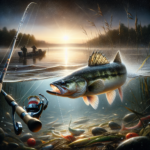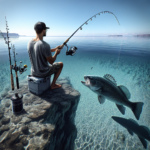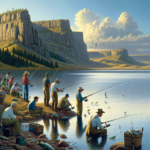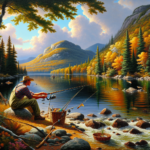Surf Fishing for Red Drum in Georgia’s Coastal Waters
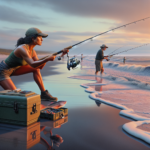
Introduction
Did you know that Georgia’s coastal waters are home to one of the most sought-after game fish in the southeastern United States? The Red Drum, also known as Redfish, is a prized catch for anglers due to its fighting spirit and delicious taste. This article will delve into the intricacies of surf fishing for Red Drum in Georgia’s coastal waters, covering everything from the best fishing techniques and gear to the top fishing spots and seasonal considerations.
Whether you’re a seasoned angler or a novice looking to try your hand at surf fishing, understanding the nuances of targeting Red Drum in Georgia can significantly enhance your fishing experience. This guide aims to provide you with all the information you need to make your next fishing trip a success.
Background/Context
Historical or Cultural Significance
Red Drum have been a staple in the coastal waters of Georgia for centuries. Historically, they were a vital food source for Native American tribes and early settlers. Today, they hold a special place in the hearts of recreational anglers and are celebrated in local fishing tournaments and festivals.
Geographical Overview
Georgia’s coastline stretches for about 100 miles along the Atlantic Ocean, featuring a diverse range of ecosystems, including estuaries, salt marshes, and barrier islands. The region’s mild climate and rich biodiversity make it an ideal habitat for Red Drum. The coastal waters are teeming with baitfish, crabs, and shrimp, providing ample food for these voracious predators.
Key Points/Details
Fishing Techniques
Technique Overview
Surf fishing for Red Drum involves casting baited hooks from the shoreline into the surf zone where these fish are known to feed. Common techniques include bottom fishing with natural baits like shrimp, mullet, and crabs, as well as using artificial lures that mimic the movement of these prey items.
When and Where to Use
The best time to surf fish for Red Drum is during the fall and spring when they are most active. Early morning and late afternoon are prime times, as Red Drum tend to feed more aggressively during these periods. Popular spots include Tybee Island, Jekyll Island, and St. Simons Island, where the surf conditions are ideal for this type of fishing.
Recommended Gear
- Rods: A medium to heavy surf rod, typically 10-12 feet long, is ideal for casting long distances.
- Reels: A sturdy spinning reel with a high line capacity (20-30 lb test line) is recommended.
- Lines: Braided lines are preferred for their strength and sensitivity.
- Bait: Fresh or frozen shrimp, mullet, and blue crabs are excellent choices.
- Lures: Soft plastics, spoons, and topwater plugs can also be effective.
Species Information
Species Overview
Red Drum (Sciaenops ocellatus) are known for their distinctive reddish-bronze color and a characteristic black spot near the tail. They inhabit shallow coastal waters and are often found in estuaries, bays, and tidal creeks. Red Drum are opportunistic feeders, preying on a variety of small fish, crustaceans, and mollusks.
Best Practices
To successfully catch Red Drum, it’s essential to present your bait naturally and be patient. Use circle hooks to increase your chances of a successful hook-up and reduce harm to the fish. Pay attention to tidal movements, as Red Drum are more likely to feed during incoming and outgoing tides.
Location Information
Top Fishing Spots
- Tybee Island: Known for its wide beaches and strong surf, Tybee Island is a hotspot for Red Drum fishing.
- Jekyll Island: Offers a variety of fishing environments, from sandy beaches to rocky jetties.
- St. Simons Island: Features numerous access points and is renowned for its productive surf fishing.
Regulations and Licenses
Anglers must adhere to Georgia’s fishing regulations, which include size and bag limits for Red Drum. A valid Georgia fishing license is required for all anglers aged 16 and older. It’s crucial to stay updated on current regulations, as they can change seasonally.
Seasonal Considerations
Seasonal Variations
Fishing conditions in Georgia’s coastal waters can vary significantly throughout the year. Fall and spring are the best seasons for Red Drum fishing, as water temperatures are optimal, and the fish are more active. Summer can also be productive, but anglers may need to fish during cooler parts of the day to avoid the heat.
Best Times to Fish
The optimal times to fish for Red Drum are during the early morning and late afternoon when they are most likely to be feeding. Tidal movements also play a crucial role, with incoming and outgoing tides being the most productive periods.
Events and Tournaments
Event Overview
Georgia hosts several fishing tournaments and events throughout the year, many of which include categories for Red Drum. Notable events include the Golden Isles Kingfish Classic and the Tybee Island Redfish Tournament.
Preparation Tips
To prepare for a fishing tournament, ensure your gear is in top condition, practice your casting techniques, and familiarize yourself with the tournament rules and regulations. Pre-fishing the area can also give you a competitive edge.
Tips and Best Practices
General Tips
- Always check the weather forecast before heading out.
- Use fresh bait whenever possible for better results.
- Pay attention to local fishing reports for the latest information on fish activity.
Avoid Common Mistakes
- Avoid using too heavy a line, as it can reduce your casting distance and spook the fish.
- Don’t ignore the importance of tidal movements; plan your fishing trips around the tides.
- Ensure your bait is securely attached to avoid losing it in the surf.
Advanced Techniques
- Experiment with different types of lures to see what works best in various conditions.
- Use a fish finder to locate schools of Red Drum more efficiently.
- Practice long-distance casting to reach fish that are further out in the surf.
Gear and Equipment Recommendations
Essential Gear
- Medium to heavy surf rod (10-12 feet)
- Spinning reel with high line capacity
- Braided fishing line (20-30 lb test)
- Circle hooks
- Fresh or frozen bait (shrimp, mullet, crabs)
Optional Gear/Upgrades
- Fish finder
- Waders for fishing in deeper water
- Rod holders for hands-free fishing
- Tackle box with a variety of lures and rigs
Where to Buy or Rent
Local bait and tackle shops in coastal Georgia towns are excellent places to purchase or rent fishing gear. Online retailers like Bass Pro Shops and Cabela’s also offer a wide range of equipment suitable for surf fishing.
Safety and Conservation
Safety Tips
- Always wear a life jacket when fishing near deep water or strong currents.
- Be aware of weather conditions and avoid fishing during storms or high winds.
- Use sunscreen and stay hydrated to protect yourself from sun exposure.
Conservation Practices
- Practice catch and release to help sustain Red Drum populations.
- Respect local wildlife and avoid disturbing their habitats.
- Follow all fishing regulations and report any violations to authorities.
Planning Your Trip
Accommodations
There are numerous lodging options near Georgia’s top fishing spots, ranging from beachfront hotels and vacation rentals to campgrounds and RV parks. Popular choices include the Jekyll Island Club Resort and the King and Prince Beach & Golf Resort on St. Simons Island.
Travel Tips
Georgia’s coastal areas are easily accessible by car, with major highways leading to popular fishing destinations. The closest airports are Savannah/Hilton Head International Airport and Brunswick Golden Isles Airport, both of which offer car rental services.
Additional Activities
When you’re not fishing, explore the rich history and natural beauty of Georgia’s coastal towns. Visit historic sites like Fort Pulaski National Monument, take a guided kayak tour through the salt marshes, or enjoy the local cuisine at one of the many seafood restaurants.
Frequently Asked Questions (FAQs)
What is the best time of year to fish for Red Drum in Georgia?
The best times are during the fall and spring when water temperatures are optimal, and Red Drum are most active.
Do I need a fishing license to surf fish in Georgia?
Yes, a valid Georgia fishing license is required for all anglers aged 16 and older.
What bait works best for catching Red Drum?
Fresh or frozen shrimp, mullet, and blue crabs are highly effective baits for Red Drum.
Are there any size or bag limits for Red Drum in Georgia?
Yes, Georgia has specific size and bag limits for Red Drum. It’s essential to check the latest regulations before fishing.
Conclusion
Surf fishing for Red Drum in Georgia’s coastal waters offers an exciting and rewarding experience for anglers of all skill levels. By understanding the best techniques, gear, and locations, you can increase your chances of landing this prized game fish. Remember to follow local regulations, practice conservation, and prioritize safety to ensure a successful and enjoyable fishing trip.
So, grab your gear, head to the beautiful beaches of Georgia, and experience the thrill of surf fishing for Red Drum. Happy fishing!

